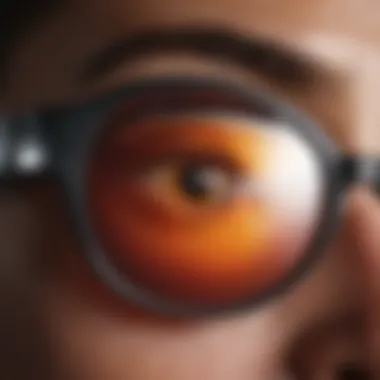Sunglasses for Retinitis Pigmentosa: A Vital Support


Intro
Retinitis pigmentosa (RP) is a complex genetic condition that primarily affects the retina, leading to diminishing vision over time. For those living with RP, the world can often seem like a darkening room; light sensitivity and glare become persistent hurdles in daily life. This article will provide an in-depth exploration of how specially designed sunglasses can play a vital role in alleviating some of these challenges.
The objective here is not merely to discuss the aesthetics of sunglasses but to delve deeper into their functionality and potential impact on the quality of life for those affected by RP. We will explore essential features in sunglasses tailored for these individuals, noting the significance they hold in creating a more manageable visual environment. Additionally, we will examine what previous research indicates regarding the advantages of using protective eyewear, helping to build a case for those considering these vital tools.
Through a thorough analysis of both the scientific and personal narratives connected to sunglasses and RP, this article aims to shed light on the often-overlooked implications of this discourse, broadening the understanding of how improving visual comfort can lead to enhancing social interactions and psychological well-being.
Understanding Retinitis Pigmentosa
The exploration of Retinitis Pigmentosa (RP) is essential to grasp the complex world of retinal degeneration and its effects. Understanding RP entails more than just the medical particulars; it connects emotions, life choices, and the reality of managing a progressive condition. When one comprehends the nuances of this disorder, it sheds light on why specific solutions, such as sunglasses, are not just handy accessories but vital tools for daily living among affected individuals.
Definition and Overview
Retinitis Pigmentosa is a hereditary disorder that causes gradual deterioration of the retinal photoreceptors. These photoreceptors are crucial for converting light into signals that the brain interprets as images. The disorder primarily affects rods—responsible for night vision—and later cones, which are essential for color vision and visual acuity. In layman’s terms, if you picture the retina as the film of a camera, RP acts like a gradual smudge obstructing clarity and vibrancy of the images that one sees.
Genetic Factors and Inheritance Patterns
The genetic underpinnings of RP are quite intricate. Various gene mutations can trigger the onset of the condition, with numerous inheritance patterns existing—autosomal dominant, autosomal recessive, and X-linked. For instance, if an individual has an affected parent, there’s a chance of inheriting the condition through dominant genes, manifesting at varying ages depending on the specific mutation. Understanding these genetic factors is instrumental for families; knowing whether they carry certain genes can help them make informed decisions about family planning and seek genetic counseling where necessary.
Stages and Symptoms of RP
Recognizing the stages and symptoms of Retinitis Pigmentosa is crucial for both patients and caregivers. The progression can differ significantly among individuals. Early signs usually include difficulty seeing in low light, a notable challenge when traversing dimly lit spaces. As the disease advances, peripheral vision diminishes—often leading a patient to rely heavily on their remaining central vision. Here are some common stages and symptoms:
- Night blindness: This may be among the first indicators, causing discomfort or even anxiety in dark environments.
- Tunnel vision: Over time, the field of vision narrows, making it feel as if one is peering through a telescope.
- Color perception issues: As cones deteriorate, the vibrancy of colors may fade, becoming muted or entirely lost.
Understanding these symptoms not only helps in early detection but also informs the necessity for adaptive measures, including specialized eyewear. Taking steps to manage these visual challenges can foster a greater sense of agency and quality of life, making it imperative to act upon symptoms promptly.
Light Sensitivity in Retinitis Pigmentosa
Impact of Light Sensitivity on Daily Life
Individuals living with retinitis pigmentosa (RP) often experience heightened sensitivity to light, an aspect that can greatly affect their day-to-day existence. This light sensitivity can cause discomfort, making it hard for them to navigate environments that would typically be easy for others. When walking outdoors on a sunny day, the brightness can feel overwhelming. Such situations can lead to not only physical discomfort but also an emotional toll, as daily activities become challenging.
The need to shield one's eyes from bright light goes beyond mere comfort—it becomes a profound necessity. Even inside illuminated spaces, harsh lighting can cause strain and exacerbate the existing symptoms of RP, leading to a kind of isolation as affected individuals might avoid situations where bright lights are present. This can have consequences for social interactions, hobbies, and even work environments. Eye fatigue becomes a frequent companion, making some activities seem more daunting than they really are, thereby affecting overall quality of life.
Glare and Its Effects
Glare acts like an uninvited guest at the party of visual clarity for people with RP. It can disrupt vision and make it difficult to discern objects or faces, effectively throwing a wrench in the works of daily activities. Glare often comes in two forms—disability glare, which affects one's ability to see in bright environments, and discomfort glare, a sensation that can lead to squinting or even headaches.
For those with RP, the presence of glare can severely limit mobility and independence. When attempting to drive or navigate busy streets, sudden bright flashes from reflective surfaces can mean the difference between clarity and confusion. Consequently, those suffering from RP may often choose to limit their exposure to potentially glaresome conditions, opting instead for familiar routes, even if it means sacrificing spontaneity and adventure.
Light sensitivity and glare are not merely peripheral symptoms of RP—they're central to understanding the lived experience of individuals grappling with the condition. The consequences of effective management can extend beyond just comfort into realms of psychological well-being and independence. As such, understanding these aspects becomes pivotal when addressing the overall challenges faced by those living with retinitis pigmentosa.
Sunglasses: A Vital Resource


Sunglasses play a crucial role in the lives of individuals suffering from retinitis pigmentosa (RP), a condition that deeply affects how they perceive the world around them. For many, everyday activities can become monumental challenges due to heightened light sensitivity and glare. In this context, sunglasses serve not only as a protective barrier against harmful UV rays but also as a tool that enhances comfort and visual clarity.
The necessity for specialized sunglasses cannot be overstated. They offer protection from intense sunlight, detrimental glare, and even reflectivity from surfaces such as water and pavement. This safeguard is crucial because exposure to bright light can lead to discomfort and exacerbate existing vision problems, making outdoor experiences less enjoyable and less frequent for those living with RP.
"Sunglasses are not just an accessory; they are an essential component of managing life with retinitis pigmentosa."
Moreover, they contribute significantly to the psychological well-being of users. By using sunglasses, individuals often feel more empowered to engage in social activities, allowing them to experience life more fully and with greater confidence.
Purpose of Sunglasses for RP Patients
The primary purpose of sunglasses for RP patients revolves around managing light sensitivity and improving overall comfort. Light sensitivity often manifests as an intolerable reaction to bright environments, sometimes leading to migraines or fatigue. Therefore, the right pair of sunglasses can help mitigate this sensitivity and provide a layer of comfort in various lighting conditions.
In addition to alleviating discomfort, sunglasses also enable RP patients to maintain some level of independence. They can wear protective eyewear during outdoor activities, enabling them to navigate space with more confidence. This independence is essential not only for practical daily tasks but also for mental health, fostering a sense of self-sufficiency and normalcy.
Key Features for Optimal Protection
When selecting sunglasses, several key features should be considered to ensure maximum protection and comfort for individuals with RP:
- UV Protection: Sunglasses should offer 100% UV protection. This feature is vital as it prevents long-term damage to the retina and aids in maintaining remaining vision.
- Polarization: Polarized lenses can significantly reduce glare from reflective surfaces, such as water or shiny pavement. This quality allows for clearer vision and reduces the discomfort associated with bright environments.
- Wraparound Design: Sunglasses with a wraparound style encapsulate the eyes more fully, reducing light leakage from the sides. Such designs help to further shield the eyes from excessive light exposure.
- Photochromic Lenses: These lenses darken in response to sunlight and return to clear indoors. This feature can be particularly beneficial for individuals transitioning between different lighting conditions throughout their daily activities.
Lens Types and Tints
The choice of lens types and tints can greatly influence the experience of wearing sunglasses for RP patients:
- Gray Tints: Gray lenses are neutral and reduce overall brightness without altering color perception. This can be helpful in maintaining visual clarity while minimizing glare.
- Brown and Amber Tints: These colors enhance contrast and depth perception, making them ideal for navigating complex environments where clarity is required.
- Yellow and Orange Tints: Such tints improve contrast in low light conditions, which can be beneficial during dusk or dawn.
- Mirrored Lenses: These can reflect much of the sunlight that hits the surface, providing additional shield against glare.
Selecting the Right Sunglasses
Choosing the appropriate sunglasses for individuals with retinitis pigmentosa (RP) is no light matter. The right pair of shades goes beyond mere aesthetic appeal; they serve a crucial role in managing the symptoms associated with light sensitivity and glare that RP patients grapple with daily. In the context of this article, selecting the right sunglasses encompasses understanding the specific needs of the wearer, which can profoundly affect their quality of life. Sunglasses tailored for RP patients can minimize discomfort and provide substantial protection against harmful UV rays, thus helping individuals reclaim their world while managing the relentless advance of this retinal disorder.
Factors to Consider
When it comes to selecting sunglasses, the choice can feel overwhelming. However, understanding key factors can narrow down the options significantly. Here are some things to keep in mind:
- UV Protection: Look for sunglasses that offer 100% UVA and UVB protection. This ensures that the eyes are shielded from long-term damage caused by exposure to the sun.
- Lens Tint: The color and shade of the lenses can greatly influence comfort and visibility. For individuals with RP, darker tints may help reduce glare. This means leaning towards grey, brown, or green lenses, as they can minimize distortion and enhance clarity.
- Polarization: Polarized sunglasses can be a game changer, particularly for managing glare when near water or in snowy conditions. This technology works by filtering out horizontal light waves, providing a clearer and more comfortable visual experience.
- Wraparound Styles: Sunglasses that wrap around provide extra coverage and prevent light from seeping in from the sides. This can be particularly beneficial during outdoor activities.
- Comfort and Fit: The physical fit of the sunglasses matters a great deal. They should sit comfortably on the face without pinching or shifting, as discomfort may lead to avoidance of wearing them altogether.
- Lens Material: Consider lenses made from polycarbonate or Trivex, as they are impact-resistant and lightweight, which adds both durability and comfort while not compromising on safety.
Taking the time to understand these factors will significantly enhance the selection process, ultimately resulting in a more satisfactory choice that directly addresses the unique challenges posed by retinitis pigmentosa.
Consulting an Eye Care Professional
While the points above offer a solid foundation for selecting sunglasses, consulting an eye care professional should never be overlooked. An ocular expert brings a world of knowledge that can guide individuals toward making informed decisions tailored specifically for their condition.
When you sit down with an eye care professional, consider discussing:
- Personalized Recommendations: Professionals can recommend sunglasses based on your specific level of light sensitivity and lifestyle needs.
- Trial Options: Some practitioners offer trial pairs, allowing patients to experience how different lens types feel in real-world situations before committing to a purchase.
- Latest Technology: Eye care professionals often have insights into the most current optical advancements and can help you find options that may not be available at retail outlets.
- Regular Assessments: Frequent eye exams can help track the progression of RP, allowing a tailored approach to sunglasses as a person's condition evolves. This proactive stance ensures that sunglasses remain effective at mitigating symptoms over time.


In summary, while selecting the right sunglasses can feel like navigating a maze, it becomes less daunting with a clear understanding of critical factors and professional guidance. Remember that the ultimate goal is to ensure that individuals living with retinitis pigmentosa can engage with the world around them with minimal hindrance from light sensitivity.
Research and Studies on Sunglasses for RP
When discussing the role of sunglasses for individuals with retinitis pigmentosa (RP), it’s crucial to draw attention to the findings of research and studies in this field. This section sheds light on the relationship between protective eyewear and the management of light sensitivity issues commonly associated with RP. Understanding how sunglasses can alleviate discomfort, enhance quality of life, and promote safety in outdoor environments can make a remarkable difference in the patient experience.
Scientific studies highlight that specialized sunglasses not only shield the eyes from harmful UV rays but also help filter out high-energy visible (HEV) light that can exacerbate symptoms. Light sensitivity among RP patients can hinder daily activities and increase fatigue, making the use of appropriate sunglasses a key consideration. Research indicates that consistent use can lead to improved visual comfort and a more enjoyable engagement with the surroundings.
In this context, it is essential to evaluate the effectiveness of various designs, tints, and features that sunglasses offer to RP individuals. Factors such as lens polarization, coatings to reduce glare, and other optical technologies play an integral role in managing challenges posed by light exposure.
Scientific Findings Supporting Sunglass Use
Numerous studies support the benefits of sunglasses in promoting eye health for those living with retinitis pigmentosa. One key study published in the Journal of Optometry assessed the reduction in glare when specialized sunglasses were worn by RP patients. The findings showed that individuals wearing sunglasses specifically designed to filter out blue light experienced significantly less visual discomfort compared to those without protective eyewear.
Moreover, another investigation highlighted the impact of UV filters in protecting the retina from oxidative stress, which is vital for preserving remaining vision. Findings revealed that consistent usage of sunglasses with high UV protection reduced the rate of degenerative changes in the retinal cells. To reinforce this, optometrists emphasize the importance of sunglasses in shielding eyes from potential harm that increases as environmental conditions worsen, particularly for light-sensitive individuals.
- Key Benefits Noted in Research:
- Reduction in glare and visual discomfort
- Protection against UV and blue light exposure
- Enhanced outdoor experience and increased participation in daily activities
This body of research collectively urges a broader understanding of how sunglasses can effectively serve as a crucial supportive tool for those with RP, influencing both their emotional and physical well-being.
Case Studies and Patient Testimonials
Let’s delve deeper into personal accounts that further illustrate the role of sunglasses for individuals managing retinitis pigmentosa. Various case studies have documented the stories of patients who have integrated sunglasses into their daily lives, underscoring the substantial effects on their vision experience and overall lifestyle.
For instance, one patient, who faced challenges with daylight, reported that wearing customized sunglasses not only eased the discomfort associated with glare but also allowed her to engage more enjoyably in outdoor activities. She noted, "Moving around in bright light used to be a real struggle for me. These sunglasses have been a game changer, giving me confidence to do things I love again."
Another compelling testimonial from a teenager diagnosed with RP highlighted the psychological aspects of using sunglasses. The patient shared, "I used to avoid social gatherings due to my light sensitivity. Now, when I wear my shades, I can focus on having fun instead of worrying about discomfort. It's like a shield, protecting me while allowing me to be part of the moment."
These individual stories powerfully convey how sunscreen usage can transcend mere physical protection. They highlight the psychological relief that comes from feeling secure in one's environment. The ongoing research combined with patient experiences reflects a vital understanding that sunglasses are not just an accessory; they play a critical role in restoring confidence and encouraging social interaction.
"Sunglasses are my armor against the world’s brightness, enabling me to reclaim my life."
In summary, research and personal accounts converge to emphasize that sunglasses are indeed an essential resource for individuals with retinitis pigmentosa. They empower users by enhancing their visual comfort, promoting outdoor participation, and fostering self-assuredness in various social settings. Through continued exploration of scientific inquiry and real-life experiences, we can better grasp the profound role sunglasses play in managing the challenges of RP.
The Psychological Impacts of Sunglasses
The significance of sunglasses transcends far beyond mere protection from sunlight. For individuals grappling with retinitis pigmentosa (RP), sunglasses can serve as a beacon of empowerment. The challenges posed by light sensitivity and glare are daunting, yet the right pair of sunglasses could shift the balance, altering the narrative of their daily lives.
Sunglasses not only protect the eyes but also influence one's mental framework. Wearing them can enhance comfort and lessen the strain caused by bright environments. This, in turn, cultivates a more positive self-perception among wearers, fostering a sense of autonomy over their conditions. Ultimately, along with providing physical protection, sunglasses play a crucial role in enhancing psychological well-being.
Empowerment Through Protection
For many who deal with RP, the world can feel awash in a haze of uncertainty, especially when encountering bright lights. This can lead to hesitancy in social situations or reluctance to partake in outdoor activities. Wearing specialized sunglasses thus acts as a form of empowerment. By shielding the eyes from excessive light, they equip individuals with confidence, allowing them to step outside without fear of discomfort.


It's important to recognize how a small accessory like sunglasses can affect one's mood and overall outlook on life. When individuals feel protected, their engagement in the world increases. They might join a friend for a walk in the park or attend a family event without trepidation. The simple act of pulling on a pair of sunglasses can signal readiness to embrace experiences, turning potential barriers into bridges for engagement.
"Sunglasses can transform the mundane into the manageable; they give individuals the reassurance to enjoy what the world has to offer."
Social Interactions and Confidence
When discussing the psychological impacts of sunglasses, one cannot overlook their light-hearted influence on social interaction. For those with RP, sensitive vision can easily lead to feelings of exclusion in social settings where bright lights are prevalent. Sunglasses mitigate this issue, allowing for an easier navigation of social dynamics.
Consider the scenario of dining outdoors — a setting that often presents bright reflections. The wearer of suitable sunglasses is less likely to squint or flinch in discomfort, creating a more relaxed environment not only for themselves but also for their companions. Such an atmosphere allows for smoother conversations and deeper connections, providing a sense of belonging and acceptance.
In addition, sunglasses can also safeguard against unsolicited attention or questions. Wearing them can create a subtle barrier that signals to others that one wishes to maintain a degree of privacy, allowing them to participate in social events with less anxiety.
In summary, the psychological impacts of sunglasses extend significantly beyond mere comfort. They encapsulate empowerment, belonging, and confidence, granting those with retinitis pigmentosa the tools to face the world. As such, it's crucial that those affected recognize the array of benefits that come with the right pair of sunglasses.
The Future of Sunglasses Made for RP
As we look ahead, the realm of sunglasses tailored for individuals with retinitis pigmentosa continues to evolve. The importance of this topic lies in its potential to improve the everyday lives of those who battle light sensitivity and visual impairment. The advancements in technology and design not only enhance visual comfort but also cater to a broader range of needs that RP patients encounter.
Innovations in Optical Technology
In the light of ongoing research, significant strides are being made in optical technology that directly benefits RP patients. One primary area is the development of adaptive lens technology. These lenses can adjust their tint based on the intensity of light—imagine walking outdoors and your sunglasses react instantly, darkening to shield against sudden brightness. This innovation allows individuals to experience a more comfortable transition between environments, alleviating the shock of entering and exiting buildings or moving from shaded areas to sunnier spots.
Moreover, manufacturers are exploring smart sunglasses that incorporate UV filtration and glare reduction with digital enhancement features. For example, integrating augmented reality could offer individuals assistance in navigating their surroundings safely using contrasting visuals.
In addition, there’s a growing trend in using photochromatic materials that provide excellent UV protection while adapting their shades as per the sunlight exposure. This means that while enjoying a sunny day, RP patients can experience a seamless transition in lens color while maintaining optimal eye protection.
Potential Developments in Design
Fashion and function are coming together in exciting ways for an accommodating eyewear future. Designs are becoming increasingly inclusive, not only tailored to aesthetic preferences but also to the practical needs of those with RP. For instance, larger frames are being introduced to provide more extensive side coverage from light, reducing peripheral glare significantly.
The materials used in the production of sunglasses are also on an upward trajectory. Lighter and more comfortable materials can now be integrated into eyewear. Innovations such as hypoallergenic components and improved strap systems allow for secure fitting without discomfort, making them suitable for prolonged use.
"The future of product design should weave together functionality and user experience in a way that enhances daily living for individuals facing unique challenges."
As advancements continue, it is essential to keep the dialogue open among professionals, patients, and researchers to ensure that the developments remain aligned with the real-world experiences of RP individuals.
Finale
The conclusion serves as the capstone of our exploration into sunglasses for individuals grappling with retinitis pigmentosa (RP). It ties together the intricate benefits sunglasses bring to the table, beyond mere fashion. Understanding how vital these protective glasses are can be the difference between comfort and discomfort in daily life.
Summarizing the Importance of Protection
It cannot be overstated that protection from harmful light is paramount for those with RP. People with this condition often navigate a world flooded with bright light and glare that exacerbates their vision problems. Sunglasses designed with specific features like UV protection and anti-glare materials can make a significant difference. They are not just an accessory; they are a necessary shield enabling individuals to venture out confidently.
- UV Protection: Regular exposure to UV rays can further damage the already compromised retina. Specialized sunglasses block these harmful rays.
- Glare Reduction: Certain lens tints dramatically reduce glare, making it easier to focus and see clearly. This can transform how one perceives the environment.
- Comfort Enhancement: The right pair of sunglasses can eliminate discomfort, allowing for smoother transitions in changing lighting conditions.
By emphasizing the importance of these protective eyewear, we shine a light on how they contribute significantly to bettering the lives of RP patients.
Encouraging Awareness and Research
Encouraging further research into optimized sunglasses designs could lead to groundbreaking improvements in patient care. Developing lenses that offer enhanced protection while maintaining aesthetic appeal opens doors in many ways. Imagine a world where individuals with RP don’t have to make sacrifices between style and comfort.















